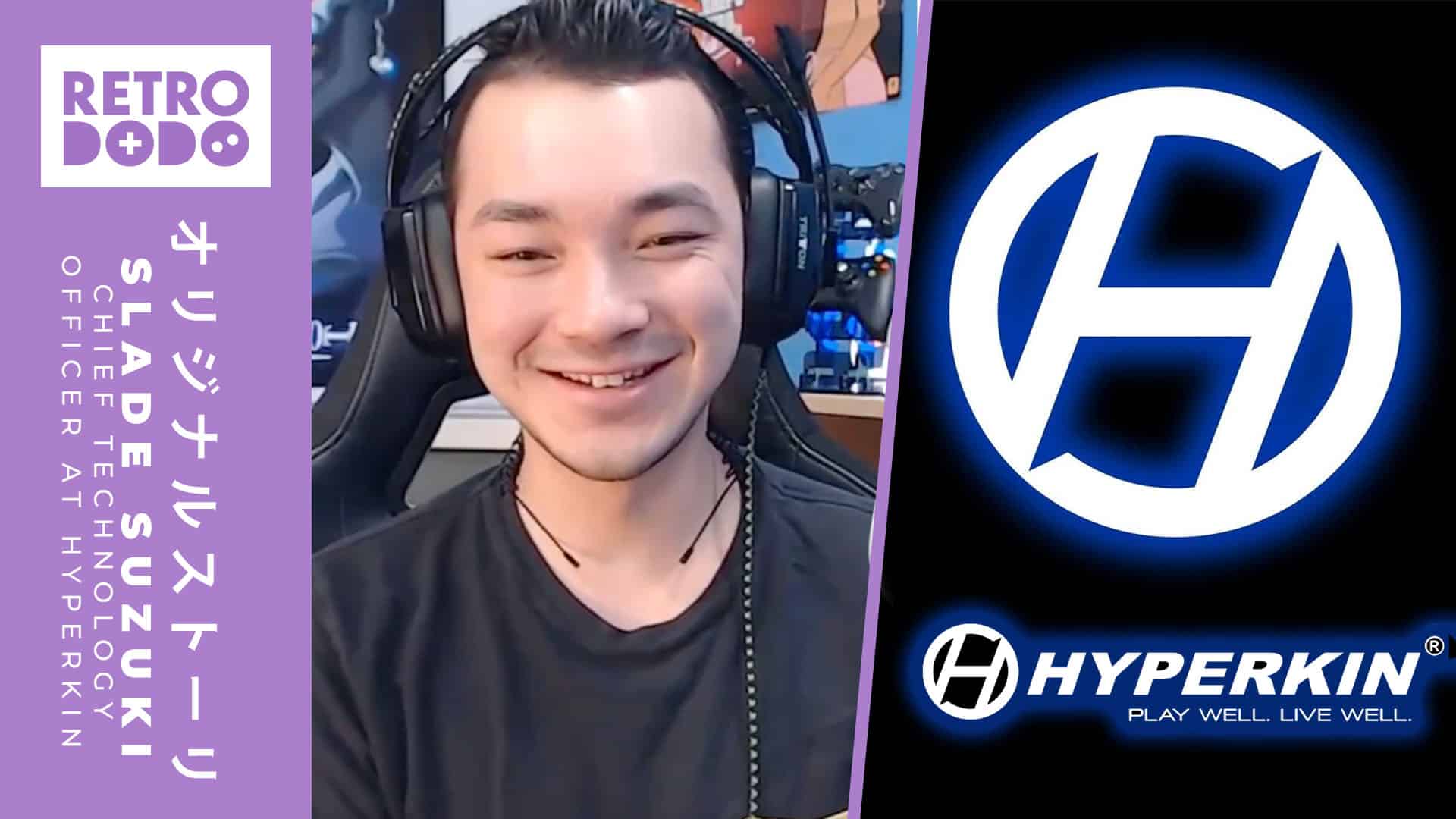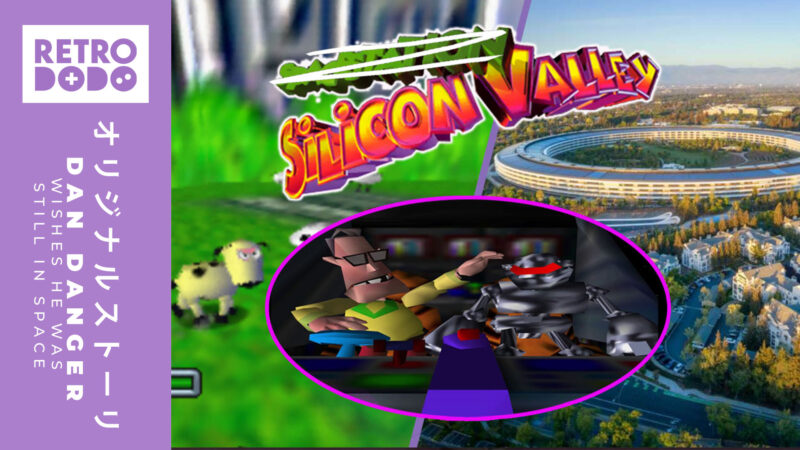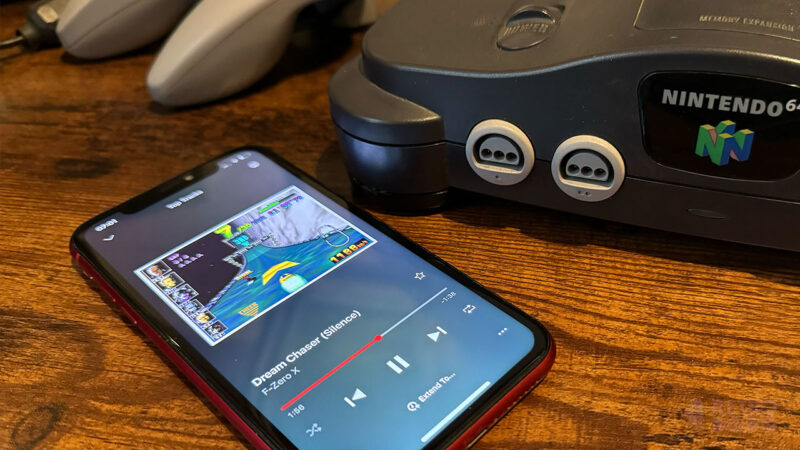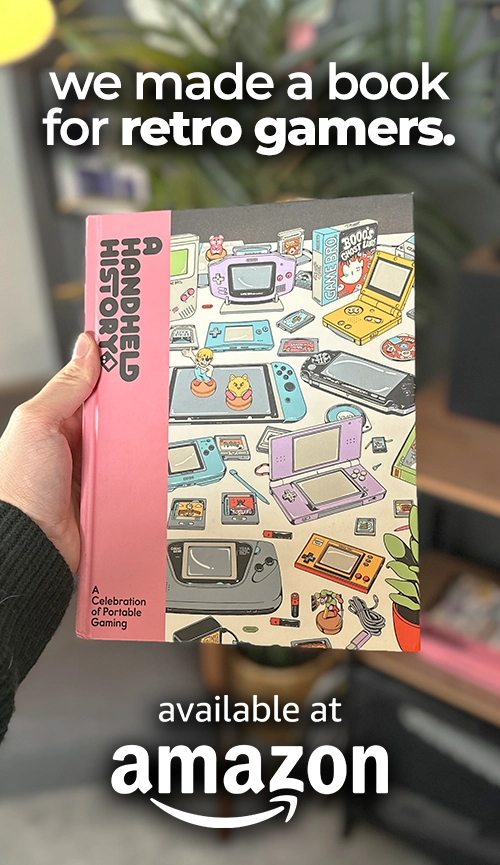Retro gamers around the world will definitely know about Hyperkin. Over the years they’ve specialised in creating affordable solutions for gaming both at home and on the go, allowing us to replay our favourite media on old and new consoles and adding new quality of life features we’ve grown used to like the ever-handy ‘rewind’ along the way – it definitely makes playing Galaga a lot more enjoyable!
We’ve covered lots of Hyperkin’s products over the years; from HDMI cables to the SupaBoy & RetronSQ, they’re a huge name not just in the Retro Space but in the world of gaming as a whole. We spoke to the company’s Chief Techincal Officer Slade Suzuki on the Retrospect Podcast about product development and the future of Hyperkin as well as finding out more about the small team who have such a big impact on gamers everywhere.
The interview that follows is made up of extracts taken from the transcript of our podcast record with Slade while at Hyperkin HQ. You can find the full episode at the very bottom of this article, but for now, let’s get to know Slade and his role in the company!
Table of Contents
Getting To Know Slade Suzuki, Hyperkin’s CTO
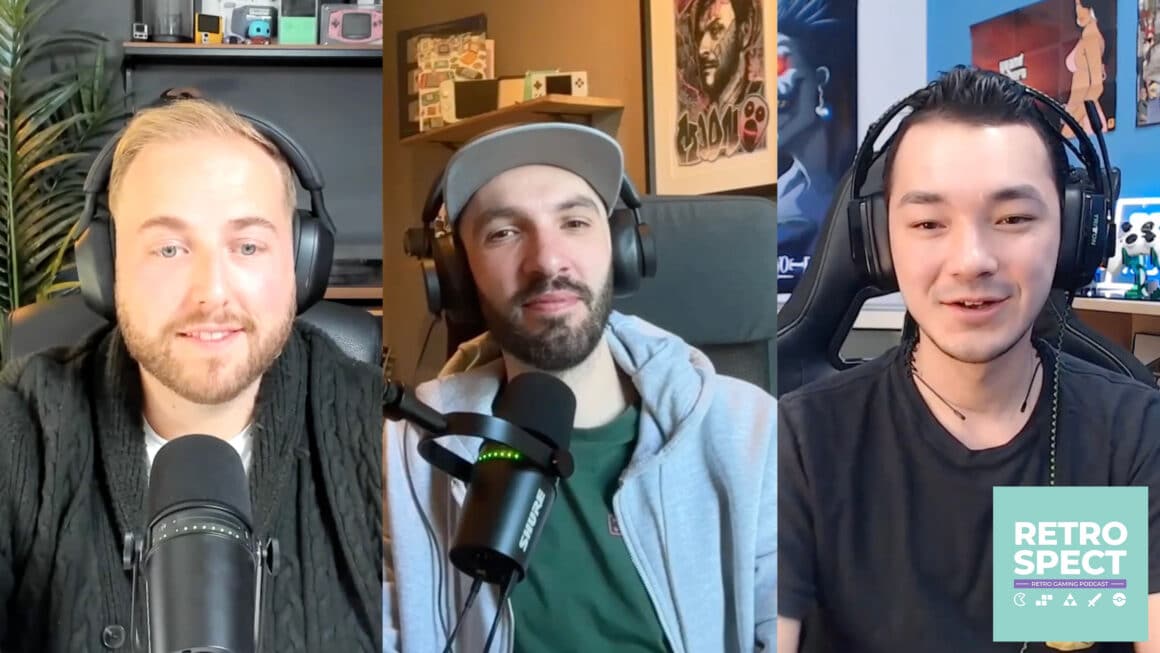
RD: As avid retro gamers, we’ve used quite a few of your products in the past, so it’s exciting to have you on. If you could just briefly introduce yourself, Slade, and give our audience an introduction to who you are and what you do.
SS: Hey, guys. My name is Slade Dude Suzuki. I am the CTO here at Hyperkin. What that entails is I’m the lead product developer, head engineer, and head of the R&D team. I also manage all of our China team, as well as being a licensing director, and then a bunch of just little miscellaneous jobs along the way, such as helping out with support and RMA. So, we’re quite a lot of hats here, but it’s a lot of fun.
RD: How long have you been with the company? What’s the first product that you kind of worked on developing with Hyperkin – what’s kind of like the one that you look back on as being, this is like my entry into the company?
SS: Yeah, so that’s actually kind of a funny story. I actually started in the warehouse here, so I kind of just moved my way up over time. Before that, though, I did do a bit of marketing, just that’s kind of what I went to school for. I went to school for public relations. From there, I helped do the website, make it a little nicer. We rebranded, did a bit of a model change. They were impressed with that.
SS: They said, ‘hey, you’re pretty good at that, and our R&D guys quitting, you like tinkering with stuff, right?’ I told them, yes, I did a bunch of 3D modeling, 3D printing, but I told them I’m not an engineer. I didn’t go to school for that. They go, ‘oh no, it’s fine. You’ll learn that along the way. You’ll learn that along the way. You’re going to do great.’ So I gave it a chance and here we are now. I’m very thankful for the opportunity and it’s been a lot of fun learning along the way.
SS: I’ve been with the company, I believe, a little over two years now, two and a half. I believe the biggest product in terms of R&D and the stuff I’m doing now was the Xenon, which is our Xbox 360 replica, officially licensed with Xbox, of course. So that was kind of a really big have-at-it.
Discovering More About The Hyperkin Team
RD: So how big is the Hyperkin team? Are you just US based? I know you said you work with some of your colleagues over in China. How many bases do you have?
SS: So we are actually a lot smaller than people would, I guess you could say be led on to believe. We’re a small team. We’re really working hard here. We started as a family company back in 2006. So it’s family-owned, family-operated, and from there it grew to where it is today. We are around a team of 30, I’d say, here in the US, and then we have a few people out in China. They handle all the factory stuff that we work on, and then we have a few in Europe.We are expanding to Europe side now.
RD: I would have thought there would be a lot more people than 30. So again, it’s nice to find out about these people who make these cables and these controllers and these peripherals that we use on a day-to-day basis, especially here at Retro Dodo and retro gamers across the world.
SS: Yeah, that’s good to hear from you guys. Because we always get the occasional person on a support call yelling and being like ‘you guys are huge, why is this product malfunctioning?’ And we’re like, we’re trying our best here. In terms of our R&D team, there’s probably, I’d like to say, five of us in total around across the board.
SS: So there’s, like I said, a lot of hats that we wear, but because of that, it’s a lot of fun for more creative opportunity, more creative flow, more of like a family, I guess you could say, where I do hear from other people and other types of the similar industry, other companies where just to get one little change done, they have to talk to this person that talks to this person that has to bring it to the higher ups, and then it takes three months to decide on anything. And so here, where if we need something done, we just go and talk to one person and instantly have a meeting with the team and decide what needs to get changed or done or altered.
Preserving Gaming History
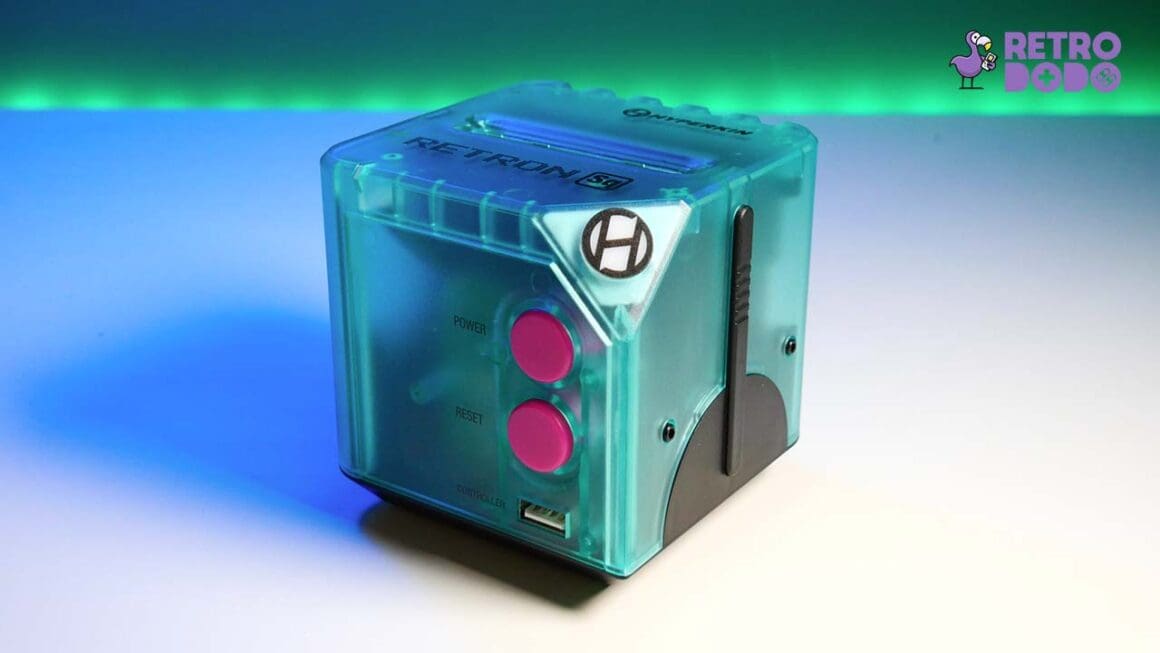
RD: How does Hyperkin value preserving gaming history. Because I know you’re doing that in a physical way with your controllers and you’re doing it software based with your cables. Is that a strong mission for Hyperkin?
SS: Every single person is a gamer here. So when we decide to make a product, it’s not… I guess you could kind of say the traditional sense where other companies might have a big giant meeting and they have tons of people that are involved with data and analytics. A lot of the times it is truly just based on the fact that we are gamers here and we just sit down and have a meeting around a little table of what have you guys been playing? What do you enjoy? What struggles do you have? Is there a cable that can make gaming easier in 2024? Why hasn’t that been done yet, etc? And from there, we could make something like an HD cable that works 3 in 1.
SS: We’re going to be coming out with a ton of new retro stuff. But at the end of the day, we took a look at where the company is and we said, you know what, we are fully capable of making modern products as well. And keeping up with all the big boys, the big players who make all the modern controllers that you would expect, even premium $200 controller with all the bells and whistles, that’s something that we’re fully capable of doing here as well.
SS: But in terms of the innovation that we’ve spoken about during this episode, a good example is the consoles that we previously announced, the Retron GX and the Mega95. With the Retron GX, we fully built in an integrated user interface that allows people to do things that they would have never been able to do on something like PC Engine or TurboGrafx. We added rewind, quick save, a bunch of cool features like that, where if you get stuck on a part in Galaga, all I do is click two buttons, and rewind it back to where I’m not dead. With our Mega 95, we took inspiration, of course, from the Switch – we thought we should come out with a handheld that changes to a console with the snap of putting it in the dock. And that’s more convenient, it’s more fun. Take it on the go for trips, it has a long battery life, and then go home, put it back on the dock, and I’m ready to play more Sonic.
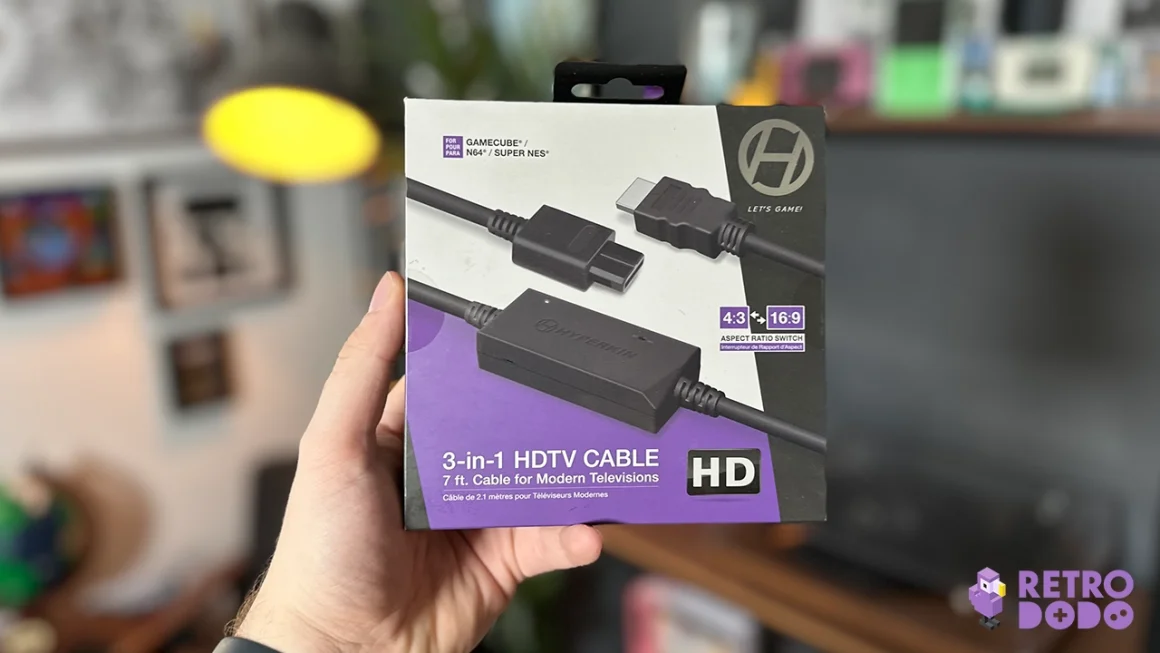
RD: We cover a lot of emulators here, and Brandon, especially over the years, has kind of taken on retro handhelds as his specialist area. He’s talked about and reviewed them in depth over the years. And people come to us because they want to look at those handhelds and those emulators to play retro games on the go, whereas you guys are providing the means of using the actual hardware to do the exact same thing, using the old cartridges we’ve got at home, and using those old save files rather than just logging on to a new retro product. So it’s nice that you guys are working on this kind of area of taking the home console out into the world as well.
SS: Yeah, and I think the key about what we do here is nostalgia, where if people want to truly encapsulate what they were doing back in their childhood, they’re gonna buy one of our products. Our 3 in 1 is one of our best sellers where you could use a bunch of different devices, upscale it to HD and just plug into the TV. I don’t have to go and grab all my cables and my CRT if I even have one nowadays to play a GameCube. It’s just as simple as plugging in one of our cables.
Research & Development
The legends over at @Hyperkin have teamed up with @spiritboxband to create this amazing controller for their Pixel Art range, and they were kind enough to send us one down to try out as well as the new Spiritbox Eva Case for Nintendo Switch! They’re both officially available in… pic.twitter.com/IjGsF6PmUM
— Retro Dodo (@retro_dodo) September 26, 2024
RD: Let’s talk more about R&D. So let’s say you got the idea of a new product, how long does it typically take you guys to take it from idea to shipping?
SS: It really depends. There’s been a lot of products here where, unfortunately, they’ve taken longer than we wanted, but it’s because it’s all for good reason. We really want to get products out right. So RetroGX is a good example. We announced the TurboGrafx, I believe, two years ago now. At the time, we thought it was pretty much done. And then we took a step back and we just kind of weren’t happy where it was.
SS: It played everything perfectly… It ran perfectly, but going back to that split decision that we could make here where we decided, why can’t we make the system better? Why can’t we make this system have rewind function and save states and different screens where you could have scan lines or you could have black and white, whatever different styles that you want. And we went back to the drawing board and we kind of redid the product from scratch, essentially, because we wanted to add all these cool features.
The Future Of Hyperkin
RD: What’s the future looking like for Hyperkin? What markets are you staying in? Are you dabbling outside of your comfort zone? Like, what can we expect from Hyperkin? More specifically in the retro space, I think is what would interest our readers.
SS: So you can expect a lot more retro from us. We are, like I said, retro is our bread and butter. We’re going to keep that rocking. We have a lot of cool products that we… I mean, we announced like the Mega 95, we announced the RetroGX, but we do have other stuff in the pipeline that we’re working on that we’re really excited about. That being said, we are working on a lot of modern stuff as well.
SS: So you could expect seeing that in the future. And then, of course, our Pixel Art line. We love the collabs that we’ve been doing, we’re really excited to go forward with that. And the future might combine both. We might have some retro characters on the pixel art soon, so you never know.
RD: Where can people follow you if they want to keep updated with your releases?
SS: We’re on everything now. We are trying to expand our TikTok especially, but we are on TikTok. We’re on Instagram, hyperkinstore.com is where you can buy all our products. We’re on Facebook, Twitter, and we’ll continue to try to engage with all the fans and answer any questions you guys may have.
Thanks to Slade for joining us on the Retrospect Podcast; I’m so glad we’ve finally been able to discover more about the team behind the brand and the processes that go into making the peripherals we and our readers use on a daily basis. If you haven’t checked out the Pixel Art Controller range, then head over to the Hyperkin Website and check out the new range. And don’t forget to listen to the full podcast episode with Slade below!

